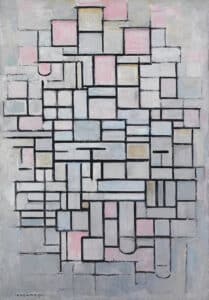

Piet Mondrian: Pioneer of Pure Abstraction
Piet Mondrian, a name synonymous with revolutionary artistic vision, reshaped the landscape of 20th-century art. His role as a leading figure in the De Stijl movement marked a dramatic departure from traditional art forms, introducing a radical approach that simplified art to its core elements. Mondrian’s work, characterized by its grids, primary colors, and straight lines, broke new ground and continues to influence a myriad of creative fields.
The Evolution of Mondrian’s Artistic Style
Born in 1872 in the Netherlands, Piet Mondrian’s artistic journey is a testament to his evolving philosophy and the relentless pursuit of a new aesthetic language.
Early Artistic Endeavors
- Mondrian began his career influenced by post-impressionism, painting landscapes that captured the natural beauty of his surroundings. These early works, rich in color and texture, hinted at his future explorations into abstraction.
Transition to Abstraction
- The turning point in Mondrian’s career came with his introduction to the avant-garde art scene in Paris. Influenced by Cubism and the works of artists like Picasso and Braque, Mondrian began experimenting with abstraction, gradually simplifying his compositions.
The De Stijl Movement and Mondrian’s Philosophy
Mondrian was not just a participant in the De Stijl movement; he was one of its chief architects. This movement, founded in the Netherlands in 1917, aimed to purify art by reducing it to its most basic elements.
Principles of De Stijl
- The De Stijl philosophy advocated for an art of simplicity and abstraction, stripping away the superfluous to reveal the essence of form and color. Mondrian, along with fellow artists and architects, sought to create a new artistic language that could express universal values.
Mondrian’s Artistic Manifesto
- For Mondrian, this journey toward abstraction was also a spiritual quest. He was deeply influenced by theosophy, a philosophical system that searches for the underlying truths of the universe. Mondrian’s art became a means to express these universal truths, using geometric forms and primary colors.
Masterpieces of Piet Mondrian
Among Mondrian’s numerous works, “Broadway Boogie Woogie,” created in 1942-43, stands out as a crowning achievement. This painting exemplifies his mature style and encapsulates his artistic and philosophical ideals.
“Broadway Boogie Woogie”: A Synthesis of Ideas
- “Broadway Boogie Woogie,” influenced by the vibrancy and rhythm of New York City, represents a culmination of Mondrian’s theories. The grid-like patterns and interplay of colors capture the dynamic pulse of the city, while maintaining the balance and harmony central to his work.
Other Notable Works
- Other significant works by Mondrian include “Composition with Red Blue and Yellow” and “Tableau I.” These paintings further illustrate his commitment to a form of art that transcends traditional representation, focusing instead on the balance and harmony of pure geometric forms.
The Impact of Mondrian Beyond the Canvas
Mondrian’s influence extends far beyond the confines of the art world. His ideas and aesthetic have permeated various aspects of modern design, architecture, and fashion.
Influence on Modern Design
- Mondrian’s style, with its emphasis on simplicity and geometric harmony, has inspired countless designers. His impact is evident in everything from graphic design to interior decor, where his principles of balance and color continue to be relevant.
Legacy in Architecture and Fashion
- In architecture, Mondrian’s influence is seen in the minimalist movement, which echoes his emphasis on form and function. In fashion, his iconic style has been repeatedly referenced, with his bold, abstract designs appearing on runways and in streetwear alike.
Conclusion: The Timeless Legacy of Piet Mondrian
Piet Mondrian’s journey from a painter of post-impressionist landscapes to a master of pure abstraction represents one of the most significant transformations in modern art. His contributions extend beyond his iconic paintings, influencing broader cultural realms and continuing to inspire creativity across the globe.
Mondrian’s unwavering pursuit of a new artistic language, one that probes the depths of spiritual and intellectual order, reminds us of the profound capabilities of art. His legacy is a testament to the power of simplicity and order in an increasingly complex world. As an artist and a visionary, Piet Mondrian’s impact on the world of art, design, architecture, and beyond is indeed unparalleled, reminding us of the enduring nature of true artistic genius.
